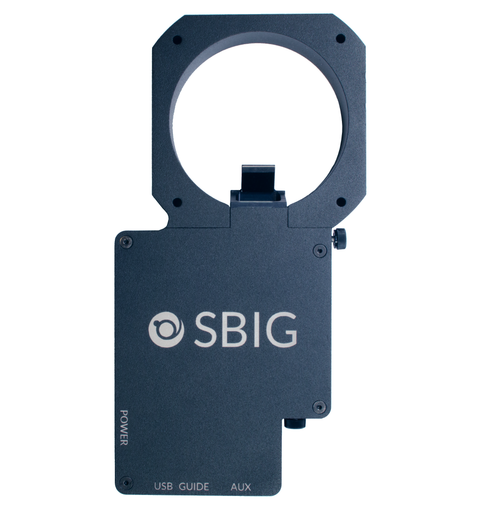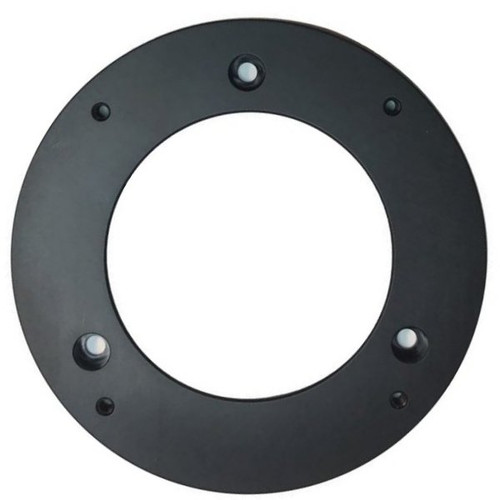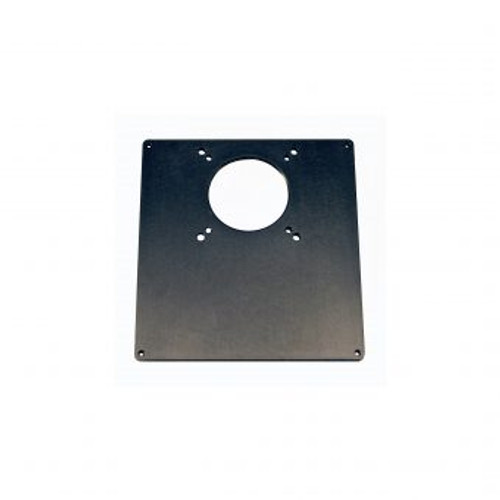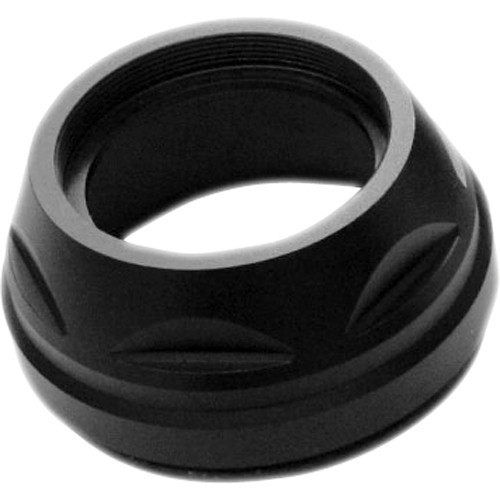Product Overview
SBIG StarChaser Off-Axis Guider Cameras
Diffraction Limited’s new SBIG StarChaser is the world’s first, all-in-one independent Off-Axis Guiding Camera with Adaptive Optics support. The StarChaser operates independently of the main camera. It combines a pick-off mirror, guider camera, guide port, and Adaptive Optics control.
Stop wasting time with ruined exposures caused by flexure between the main camera and guider. Off-axis guiding eliminates this problem by using the same optical path for the main camera and the guider.
Most off-axis guider assemblies are awkward to use, consume too much back focus, and require you to focus by slipping a camera inside an eyepiece holder. SBIG pioneered simplified off-axis guiding, with guide sensors built into CCD cameras. Later, we created the self-guiding filter wheel, placing the guide sensor in the light path ahead of photon-robbing narrowband filters. The StarChaser is the next step in this progression – a fully independent guide camera with AO capability.
Note: When using with StarChaser with AO, you will need a StarChaser to AO-X/AO-8T Adapter Cable. The necessary adapter cable is included in our StarChaser SC-3 / AO-X Bundle and StarChaser SC-2 / AO-8A Bundle.
Three Versions Available
SC-2E is designed to work with our compact SBIG cameras. It supports the AO-8A adaptive optics unit. See the table below for compatibility with various camera models.
SC-3E-SHORT is designed to work with large format SBIG cameras with shorter backfocus distance, and supports the AO-X adaptive optics unit. See the table below for compatibility with various camera models.
Adapters are also available to attach StarChaser to legacy STL cameras. For STL cameras with smaller sensors and internal filter wheel, you can use the SC-2E with the appropriate adapter. Another adapter is available to attach the SC-3E-SHORT, for STL cameras with larger sensors and the external filter wheel.
 Next-Generation Off-Axis Guiding
Next-Generation Off-Axis Guiding
The StarChaser represents our next generation of off-axis guide technology. It features a high-sensitivity 1.3 megapixel Global Shutter CMOS sensor with 4.8 micron pixels. Unlike competing autoguiders, the StarChaser has a mechanical shutter for easy dark frame correction. This feature, standard on all SBIG guiders, optimizes sensitivity and eliminates hot pixels that could degrade guiding accuracy.
The pick-off mirror position is adjustable by loosening a locking knob and sliding the mirror into or out of the housing. You can avoid vignetting the main sensor while optimizing the light path into the guide sensor. Once that is set, focus is adjusted simply by turning a second knob.
Adaptive Optics Control
Thanks to the SBIG StarChaser series, our renowned Adaptive Optics (AO) technology is now available for virtually our entire camera line! Our AO-X (available separately) bolts onto the front of the StarChaser SC-3E. Our AO-8A (available separately) bolts onto the front of the StarChaser SC-2E. The StarChaser is in turn attached to the front of an SBIG standard filter wheel and camera.
Adaptive Optics technology eliminates guiding errors caused by common mount problems such as stiction, periodic error, and wind loads. It can even reduce “slow seeing” effects resulting in higher resolution images.
Thin and Adaptable
The SC-2E is just 0.800? (20.3 mm) thick. When attaching to a filter wheel the existing adapter plate (0.147? / 3.7 mm thick) would normally be moved from the filter wheel onto the front of the SC-2E. When attaching an AO-8A to the front of the SC-2E, the adapter plate is not used.
The SC-3E is just 0.870? (22.1 mm) thick. When attaching to a filter wheel the existing plate (0.200? / 5.1 mm thick) would normally be moved from the filter wheel onto the front of the StarChaser.
Please note that smaller diameter adapter plates may vignette the guide sensor. A variety of optional adapter plates are available.
Highly Adjustable
Each StarChaser has a range of adjustment for the mirror position and the camera’s backfocus distance. The mirror position is set to avoid vignetting the main sensor and the guide sensor. The focus adjustment allows you to parfocalize the StarChaser’s guide sensor with the main camera’s sensor.
Two StarChaser models are available. The SC-2E accommodates our compact cameras such as STC-7 and Aluma CCD. The SC-3E-SHORT was designed to support our new large format CMOS cameras, which have much shorter backfocus distance than our legacy CCD models.
The StarChaser pickoff mirror can be adjusted to accommodate different sensors sizes, and it also has an impact on the focus range.
In the table below, Mirror Offset Adjustment Range gives the distance from the inner edge of the guide sensor to the optical center. To avoid vignetting, the mirror should be positioned so it clears the edge of the main sensor. At faster f/ratios the separation may need to be increased. In some optical systems if the mirror is pulled all the way back then the guide sensor may be vignetted.
Back Focus Range, Mirror Retracted gives the focus range of the StarChaser model when the mirror is pulled back as far away from the main sensor as possible. This distance is measured from the front of the StarChaser (without any adapters) to the focal plane of the main camera.
Back Focus Range, Mirror Extended gives the focus range of the StarChaser model when the mirror is adjusted as far as possible towards the main optical axis.
Supports Your SBIG Investment
Our renowned MaxIm LT software is included, providing integrated control of your StarChaser and SBIG main camera. We also provide API interfaces for third-party software running under Windows, MacOS, or Linux. An ASCOM standard camera interface is included. ASCOM does not currently support Adaptive Optics.
The StarChaser series support all currently-manufactured SBIG models, and many of the legacy models. This includes STC, Aluma AC, Aluma CCD, STX, STXL, STF-1603, STF-3200, ST-1603, ST-3200, and STL research series cameras (via available adapter).
StarChasers support AO-8A (SC-2E) and AO-X (SC-3E) Adaptive Optics units. This brings modern AO capability to many models that previously could not support AO operation. All guiding and AO operations take place independently of the main camera.
The StarChaser requires a 12V power supply (included) and a USB 2.0 mini cable (6 foot / 2 meter cable included). The StarChaser can send guider commands to the telescope either via ASCOM PulseGuide or an “ST-4” style tracking interface cable (included).
Note: When using with StarChaser with AO, you will need a StarChaser to AO-X/AO-8T Adapter Cable. The necessary adapter cable is included in our StarChaser SC-3 / AO-X Bundle and StarChaser SC-2 / AO-8A Bundle.
Recommended StarChaser Configurations
To ensure you select the correct StarChaser model, and any necessary adapters, please consult the following table.
Some combinations require a spacer or adapter. The CA-FWSPACER Filter Wheel Spacer adds 0.745? (18.9 mm), which is equivalent to the thickness of several filter wheel models. The ACC13 StarChaser SC-2 Spacer to FW8-8300 Adapter adds 0.2? (5.08 mm) and can rotate the StarChaser 45 degrees by using the threaded holes (required for some versions of the FW8-8300). The ACC18 StarChaser SC-2 Spacer adds 0.45? (14.5 mm) and is recommended when using the SC-2 with an STC-7.
Parts Included
The following parts are included with your StarChaser off-axis guide camera:
- SC-2E or SC-3E-SHORT StarChaser off-axis guide camera
- Universal AC power supply with choice of power cord (US/EU/AU)
- DC power extension cable
- Tracking Interface Cable (“ST-4” style)
- USB 2.0 A to Mini-B cable, 6 feet (2 meters)
- 7/64-inch hex key wrench
- USB flash drive
The following parts are also included with SC-3E-SHORT:
- Four 6-32 x 1-1/8? socket head cap screws
The following parts are included with SC-2E:
- Flat adapter plate 2.156 x 24 (40-12053-00)
- 2” Nosepiece adapter with cap (40-12121-00)
- Four 6-32 x 1-1/8? socket head cap screws
- ACC13 adapter plate for FW8-8300 filter wheel
The 2.156 x 24 adapter plate and 2? nosepiece adapter have a larger internal diameter to ensure the pick-off mirror is illuminated. The ACC13 allows the StarChaser SC-2E to be installed on older FW8-8300 filter wheels that have their mounting holes at a 45 degree angle.
Specifications
| Temperature Regulation | No |
|---|---|
| OS Compatibility | Windows 7, 8, 10 x86/x64, MacOS 10.14 "Mojave" x86 binaries, Ubuntu 18.04 LTS x64, Raspbian Buster armhf, Ubuntu MATE arm64 |
| Computer Interface | USB 2.0 Mini |
| Full Frame Download | 0.2 sec |
| Adaptive Optics Option | Works with AO-X (cable required) |
| Pixel Digitization Rate | 72 megapixels / second |
| A/D Converter | 10 bits |
| Weight | 0.9 lb / 400 g |
| Read Noise (typ) | 5 e- typical |
| Power | 12V, 300 mA |
| Exposure | 13.5 ns to 59.26 s |
| Pixel Size | 4.8 µm |
| Total Pixels | 1,310,720 pixels |
| Sensor Size | 6.18 mm x 4.95 mm |
| Shutter | Electronic Global Shutter plus Mechanical Dark Frame Shutter |
| Imaging Sensor | Astronomical CMOS 1.3 Megapixel |
| Filter Wheel Option | Attaches to FW7-STX and FW8S-STXL filter wheels |
| Dark Current e-/p/s | 5 e-/p/s typical at 20C |
| Imaging / Pixel Array | 1280 x 1024 pixels |
| Full Well Capacity | 10,000 e- |
| Backfocus | Adds 0.87" (22.1 mm) |








